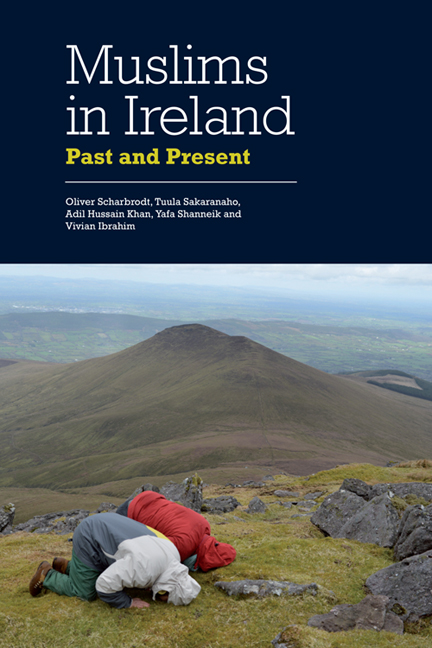Book contents
- Frontmatter
- Contents
- Figures
- Acknowledgements
- Introduction
- I History of Muslim Presence and Immigration to Ireland
- II Mosques, Organisations and Leadership
- III The Governance of Islam in the Republic of Ireland: Freedom of Religion and Islamic Education
- IV Diaspora and Identity
- Conclusion: Being Irish, Being Muslim
- Bibliography
- Index
Conclusion: Being Irish, Being Muslim
Published online by Cambridge University Press: 05 August 2016
- Frontmatter
- Contents
- Figures
- Acknowledgements
- Introduction
- I History of Muslim Presence and Immigration to Ireland
- II Mosques, Organisations and Leadership
- III The Governance of Islam in the Republic of Ireland: Freedom of Religion and Islamic Education
- IV Diaspora and Identity
- Conclusion: Being Irish, Being Muslim
- Bibliography
- Index
Summary
Various factors and variables have impacted on the formations of Irish Muslim identities and discourses: the backgrounds of Muslim immigrants, whether national, ethnic, linguistic, socio-economic or educational; the transnational links and connections between Muslims and their different communities back to their countries of origins and across Europe; and the ways in which they have organised and institutionalised Islam in Ireland, as well as the specific circumstances of the Irish context in which Muslims have settled and in which their identities and discourses have evolved. By employing a triangulation between community, context and individual as an analytical framework, this book has discussed these factors and variables.
Muslim Immigration Patterns to Ireland
Examining the trajectories of Muslim immigration to Ireland, three stages can be differentiated. Up to World War II, Muslim immigration occurred within the British colonial context. Muslims coming to Ireland were visitors, merchants, sailors, servants, students and academics, some of whom, like Mir Aulad Ali, became quite prominent in their time. Unlike in Britain, a more permanent communal presence did not emerge. In the period from World War II to the mid-1990s, the Muslim presence primarily comprised students, medical doctors, other educated professionals and a few business people who became part of the middle and upper classes of Irish society and numbered a few thousand before large-scale immigration began in the wake of the Celtic Tiger. In this sense, post-World War II Muslim immigration to Ireland differs from that to other Western European countries, whose Muslim immigrants were for the most part unskilled labourers from rural areas in their countries of origin, whose socio-economic marginalisation very often continued after settlement in Europe. Early Muslim immigrants to Ireland, by contrast, were well-educated and often from wealthy backgrounds achieving a high degree of socio-economic integration into Irish society.
During the Celtic Tiger years, Ireland transformed itself from a country of emigration to a country of immigration, leading to a rapid growth in the Muslim population within twenty years in line with the country's wider socio-cultural and religious diversification. This recent experience of religious and cultural diversity makes the Irish case similar to those of other smaller European countries such as Portugal, Greece and Finland that only began to experience major waves of Muslim immigration from the 1990s onwards.
- Type
- Chapter
- Information
- Muslims in IrelandPast and Present, pp. 216 - 229Publisher: Edinburgh University PressPrint publication year: 2015



